Case Study: Legal Risks for XYZ Company's Sales Director Selection
VerifiedAdded on 2019/10/18
|7
|1854
|312
Case Study
AI Summary
This case study examines the legal risks that XYZ Company faces in its process of selecting a new Sales Director following the retirement of Alan McSlick. The company's decision to promote internally led to four applications, and the analysis focuses on potential violations of the Equality Act. Key issues include discrimination based on sex and age against Julie Keene, who was rejected due to her gender and perceived inability to manage an older, male team. Another candidate, Aldo Viscida, faced rejection based on his writing skills and potential indirect race discrimination. Derek Constant's application was affected by his wife's illness, leading to possible discrimination by association. Mike Replica's selection, though seemingly based on merit, raises concerns about unfair practices due to his connections. The case also addresses risks associated with proposed changes in employee compensation, potential breaches of contract, violations of the national minimum wage act, unfair dismissal claims, and the introduction of mandatory medical checks. The analysis relies on relevant legal precedents and legislation to highlight the potential liabilities for the company.
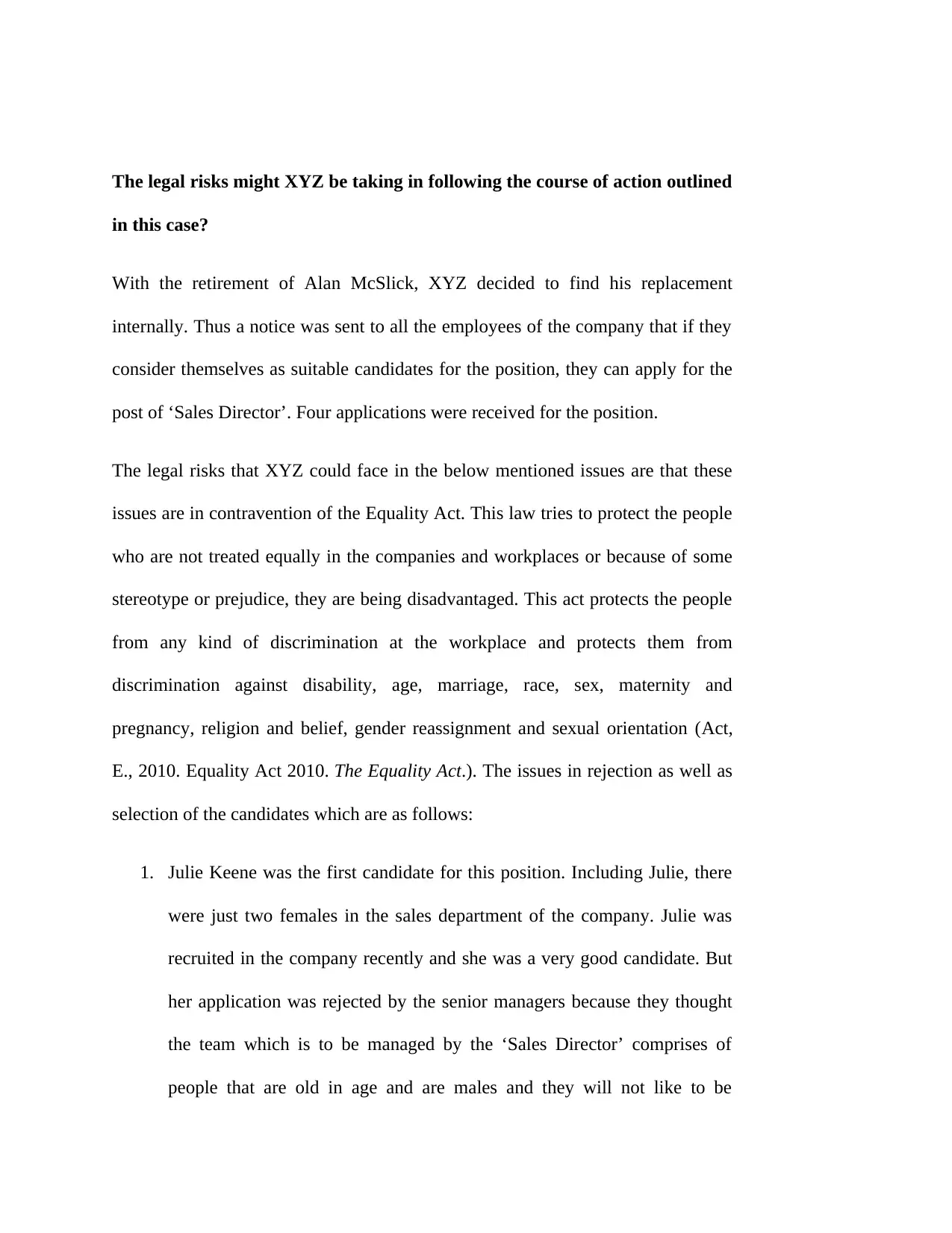
The legal risks might XYZ be taking in following the course of action outlined
in this case?
With the retirement of Alan McSlick, XYZ decided to find his replacement
internally. Thus a notice was sent to all the employees of the company that if they
consider themselves as suitable candidates for the position, they can apply for the
post of ‘Sales Director’. Four applications were received for the position.
The legal risks that XYZ could face in the below mentioned issues are that these
issues are in contravention of the Equality Act. This law tries to protect the people
who are not treated equally in the companies and workplaces or because of some
stereotype or prejudice, they are being disadvantaged. This act protects the people
from any kind of discrimination at the workplace and protects them from
discrimination against disability, age, marriage, race, sex, maternity and
pregnancy, religion and belief, gender reassignment and sexual orientation (Act,
E., 2010. Equality Act 2010. The Equality Act.). The issues in rejection as well as
selection of the candidates which are as follows:
1. Julie Keene was the first candidate for this position. Including Julie, there
were just two females in the sales department of the company. Julie was
recruited in the company recently and she was a very good candidate. But
her application was rejected by the senior managers because they thought
the team which is to be managed by the ‘Sales Director’ comprises of
people that are old in age and are males and they will not like to be
in this case?
With the retirement of Alan McSlick, XYZ decided to find his replacement
internally. Thus a notice was sent to all the employees of the company that if they
consider themselves as suitable candidates for the position, they can apply for the
post of ‘Sales Director’. Four applications were received for the position.
The legal risks that XYZ could face in the below mentioned issues are that these
issues are in contravention of the Equality Act. This law tries to protect the people
who are not treated equally in the companies and workplaces or because of some
stereotype or prejudice, they are being disadvantaged. This act protects the people
from any kind of discrimination at the workplace and protects them from
discrimination against disability, age, marriage, race, sex, maternity and
pregnancy, religion and belief, gender reassignment and sexual orientation (Act,
E., 2010. Equality Act 2010. The Equality Act.). The issues in rejection as well as
selection of the candidates which are as follows:
1. Julie Keene was the first candidate for this position. Including Julie, there
were just two females in the sales department of the company. Julie was
recruited in the company recently and she was a very good candidate. But
her application was rejected by the senior managers because they thought
the team which is to be managed by the ‘Sales Director’ comprises of
people that are old in age and are males and they will not like to be
Paraphrase This Document
Need a fresh take? Get an instant paraphrase of this document with our AI Paraphraser
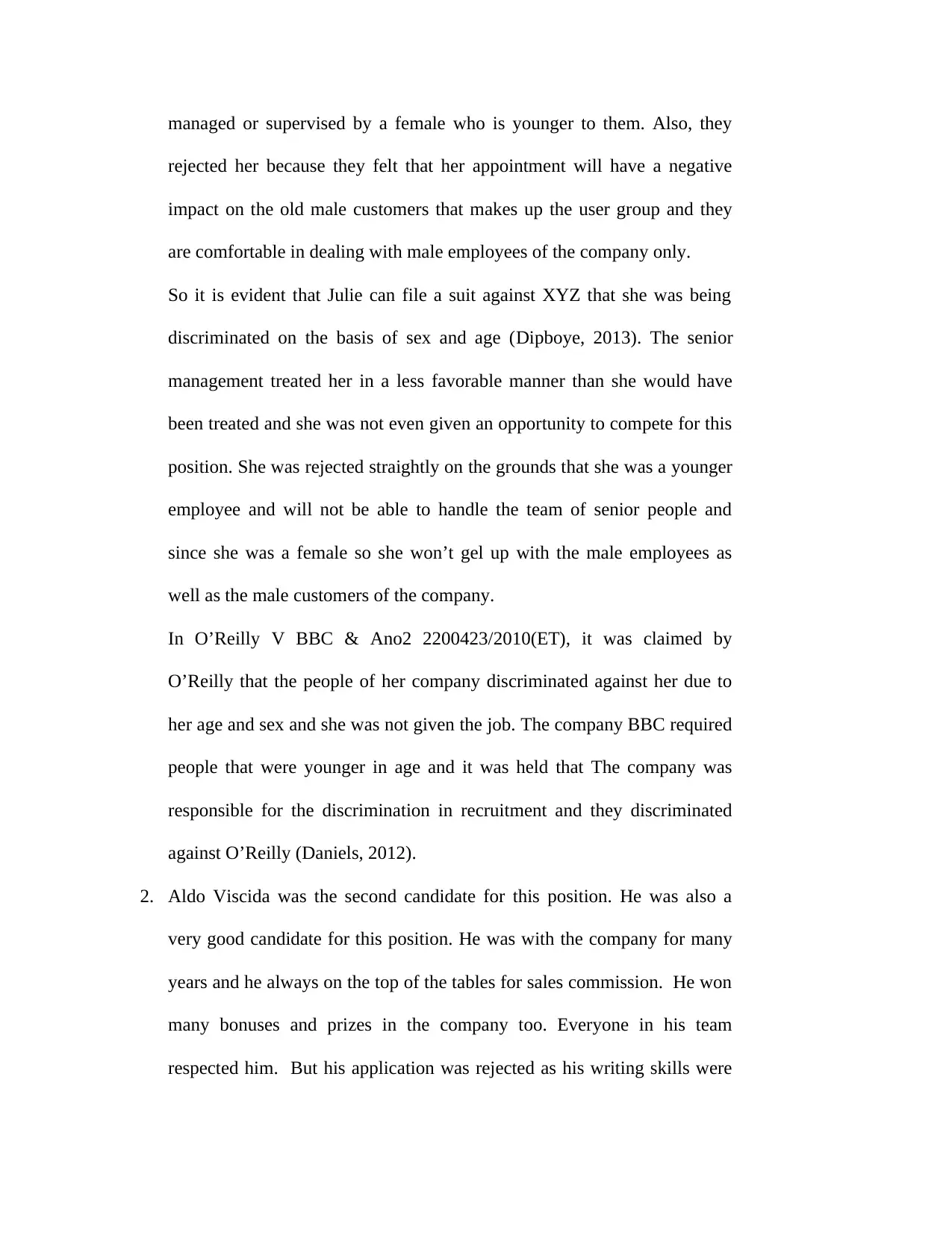
managed or supervised by a female who is younger to them. Also, they
rejected her because they felt that her appointment will have a negative
impact on the old male customers that makes up the user group and they
are comfortable in dealing with male employees of the company only.
So it is evident that Julie can file a suit against XYZ that she was being
discriminated on the basis of sex and age (Dipboye, 2013). The senior
management treated her in a less favorable manner than she would have
been treated and she was not even given an opportunity to compete for this
position. She was rejected straightly on the grounds that she was a younger
employee and will not be able to handle the team of senior people and
since she was a female so she won’t gel up with the male employees as
well as the male customers of the company.
In O’Reilly V BBC & Ano2 2200423/2010(ET), it was claimed by
O’Reilly that the people of her company discriminated against her due to
her age and sex and she was not given the job. The company BBC required
people that were younger in age and it was held that The company was
responsible for the discrimination in recruitment and they discriminated
against O’Reilly (Daniels, 2012).
2. Aldo Viscida was the second candidate for this position. He was also a
very good candidate for this position. He was with the company for many
years and he always on the top of the tables for sales commission. He won
many bonuses and prizes in the company too. Everyone in his team
respected him. But his application was rejected as his writing skills were
rejected her because they felt that her appointment will have a negative
impact on the old male customers that makes up the user group and they
are comfortable in dealing with male employees of the company only.
So it is evident that Julie can file a suit against XYZ that she was being
discriminated on the basis of sex and age (Dipboye, 2013). The senior
management treated her in a less favorable manner than she would have
been treated and she was not even given an opportunity to compete for this
position. She was rejected straightly on the grounds that she was a younger
employee and will not be able to handle the team of senior people and
since she was a female so she won’t gel up with the male employees as
well as the male customers of the company.
In O’Reilly V BBC & Ano2 2200423/2010(ET), it was claimed by
O’Reilly that the people of her company discriminated against her due to
her age and sex and she was not given the job. The company BBC required
people that were younger in age and it was held that The company was
responsible for the discrimination in recruitment and they discriminated
against O’Reilly (Daniels, 2012).
2. Aldo Viscida was the second candidate for this position. He was also a
very good candidate for this position. He was with the company for many
years and he always on the top of the tables for sales commission. He won
many bonuses and prizes in the company too. Everyone in his team
respected him. But his application was rejected as his writing skills were
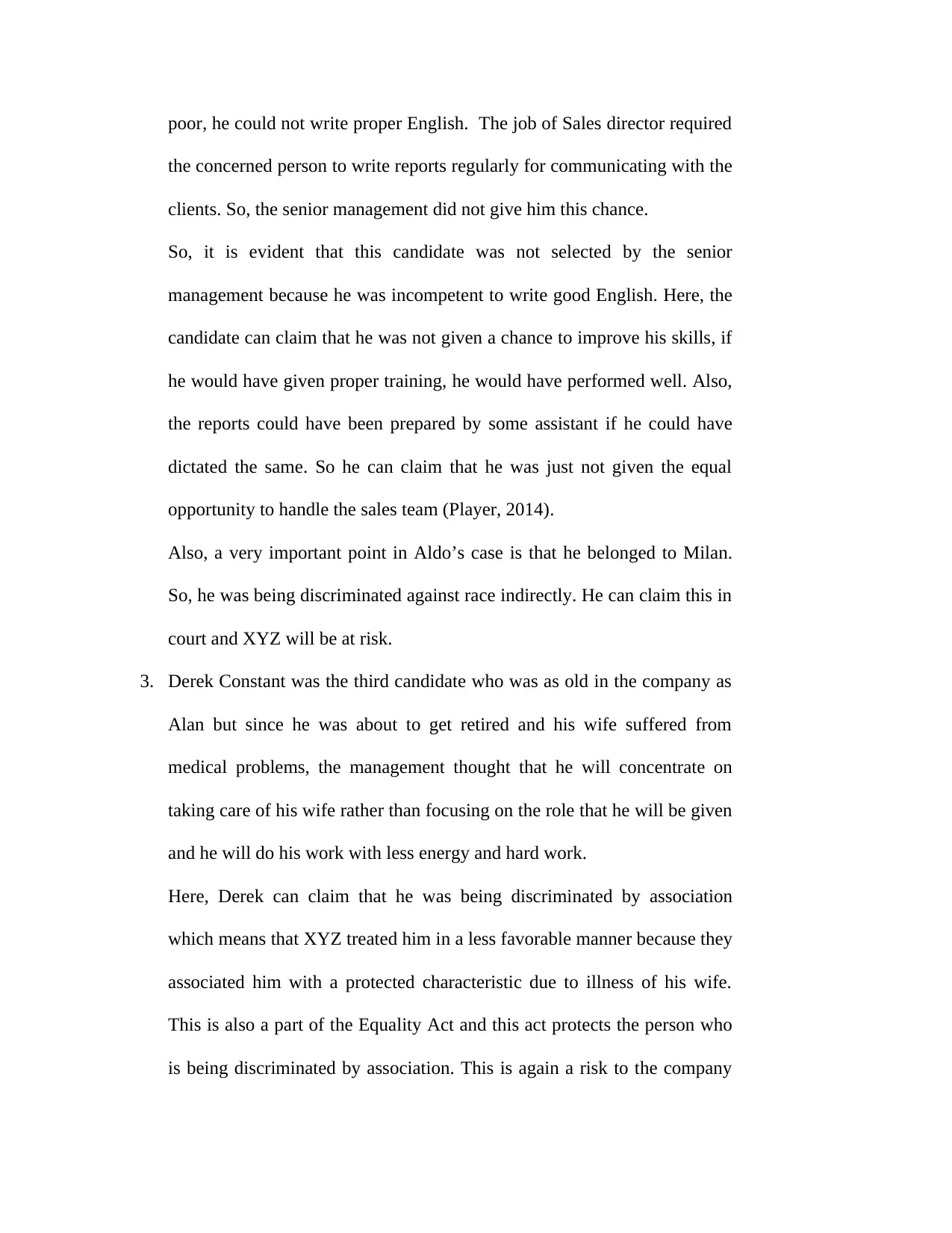
poor, he could not write proper English. The job of Sales director required
the concerned person to write reports regularly for communicating with the
clients. So, the senior management did not give him this chance.
So, it is evident that this candidate was not selected by the senior
management because he was incompetent to write good English. Here, the
candidate can claim that he was not given a chance to improve his skills, if
he would have given proper training, he would have performed well. Also,
the reports could have been prepared by some assistant if he could have
dictated the same. So he can claim that he was just not given the equal
opportunity to handle the sales team (Player, 2014).
Also, a very important point in Aldo’s case is that he belonged to Milan.
So, he was being discriminated against race indirectly. He can claim this in
court and XYZ will be at risk.
3. Derek Constant was the third candidate who was as old in the company as
Alan but since he was about to get retired and his wife suffered from
medical problems, the management thought that he will concentrate on
taking care of his wife rather than focusing on the role that he will be given
and he will do his work with less energy and hard work.
Here, Derek can claim that he was being discriminated by association
which means that XYZ treated him in a less favorable manner because they
associated him with a protected characteristic due to illness of his wife.
This is also a part of the Equality Act and this act protects the person who
is being discriminated by association. This is again a risk to the company
the concerned person to write reports regularly for communicating with the
clients. So, the senior management did not give him this chance.
So, it is evident that this candidate was not selected by the senior
management because he was incompetent to write good English. Here, the
candidate can claim that he was not given a chance to improve his skills, if
he would have given proper training, he would have performed well. Also,
the reports could have been prepared by some assistant if he could have
dictated the same. So he can claim that he was just not given the equal
opportunity to handle the sales team (Player, 2014).
Also, a very important point in Aldo’s case is that he belonged to Milan.
So, he was being discriminated against race indirectly. He can claim this in
court and XYZ will be at risk.
3. Derek Constant was the third candidate who was as old in the company as
Alan but since he was about to get retired and his wife suffered from
medical problems, the management thought that he will concentrate on
taking care of his wife rather than focusing on the role that he will be given
and he will do his work with less energy and hard work.
Here, Derek can claim that he was being discriminated by association
which means that XYZ treated him in a less favorable manner because they
associated him with a protected characteristic due to illness of his wife.
This is also a part of the Equality Act and this act protects the person who
is being discriminated by association. This is again a risk to the company
⊘ This is a preview!⊘
Do you want full access?
Subscribe today to unlock all pages.

Trusted by 1+ million students worldwide
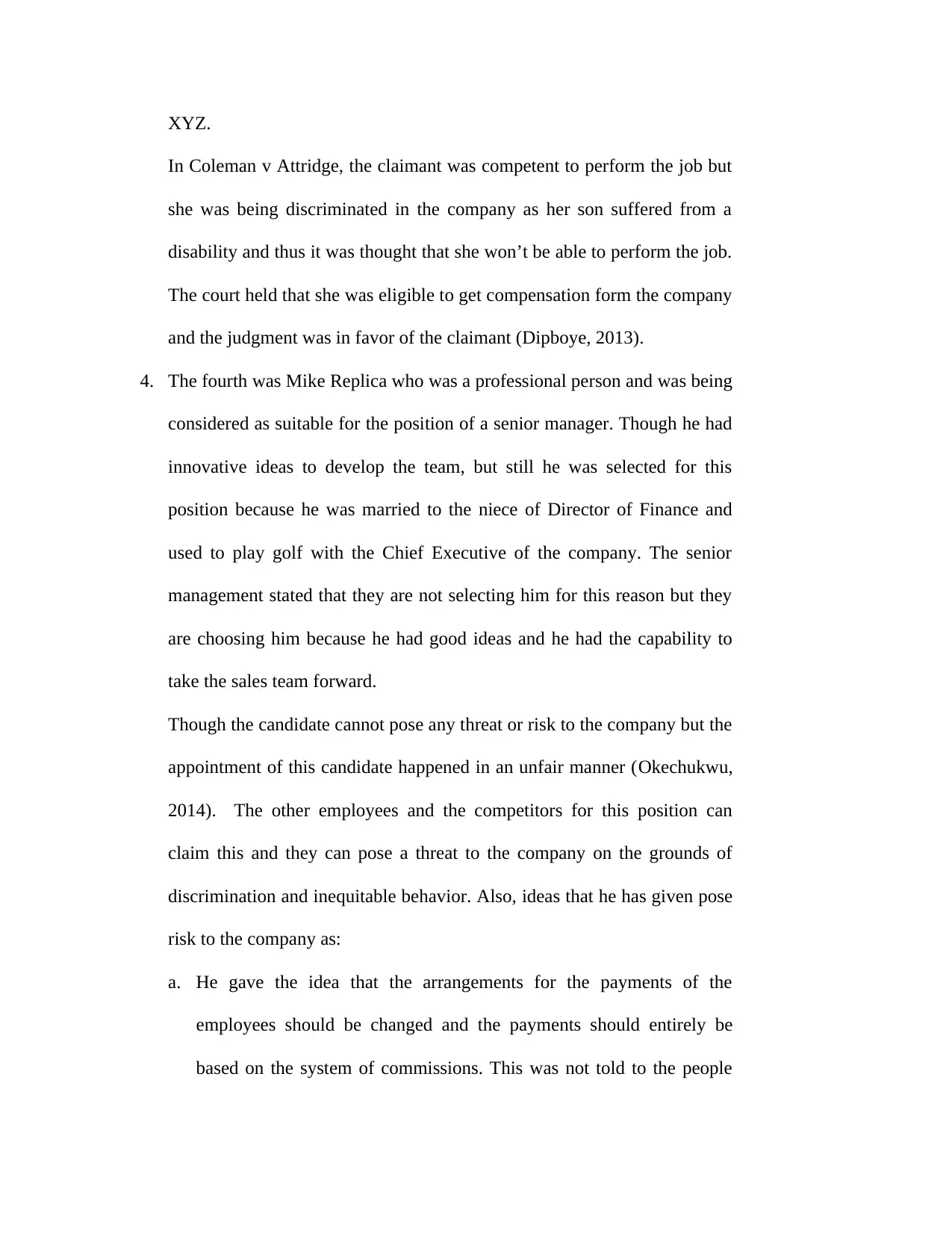
XYZ.
In Coleman v Attridge, the claimant was competent to perform the job but
she was being discriminated in the company as her son suffered from a
disability and thus it was thought that she won’t be able to perform the job.
The court held that she was eligible to get compensation form the company
and the judgment was in favor of the claimant (Dipboye, 2013).
4. The fourth was Mike Replica who was a professional person and was being
considered as suitable for the position of a senior manager. Though he had
innovative ideas to develop the team, but still he was selected for this
position because he was married to the niece of Director of Finance and
used to play golf with the Chief Executive of the company. The senior
management stated that they are not selecting him for this reason but they
are choosing him because he had good ideas and he had the capability to
take the sales team forward.
Though the candidate cannot pose any threat or risk to the company but the
appointment of this candidate happened in an unfair manner (Okechukwu,
2014). The other employees and the competitors for this position can
claim this and they can pose a threat to the company on the grounds of
discrimination and inequitable behavior. Also, ideas that he has given pose
risk to the company as:
a. He gave the idea that the arrangements for the payments of the
employees should be changed and the payments should entirely be
based on the system of commissions. This was not told to the people
In Coleman v Attridge, the claimant was competent to perform the job but
she was being discriminated in the company as her son suffered from a
disability and thus it was thought that she won’t be able to perform the job.
The court held that she was eligible to get compensation form the company
and the judgment was in favor of the claimant (Dipboye, 2013).
4. The fourth was Mike Replica who was a professional person and was being
considered as suitable for the position of a senior manager. Though he had
innovative ideas to develop the team, but still he was selected for this
position because he was married to the niece of Director of Finance and
used to play golf with the Chief Executive of the company. The senior
management stated that they are not selecting him for this reason but they
are choosing him because he had good ideas and he had the capability to
take the sales team forward.
Though the candidate cannot pose any threat or risk to the company but the
appointment of this candidate happened in an unfair manner (Okechukwu,
2014). The other employees and the competitors for this position can
claim this and they can pose a threat to the company on the grounds of
discrimination and inequitable behavior. Also, ideas that he has given pose
risk to the company as:
a. He gave the idea that the arrangements for the payments of the
employees should be changed and the payments should entirely be
based on the system of commissions. This was not told to the people
Paraphrase This Document
Need a fresh take? Get an instant paraphrase of this document with our AI Paraphraser
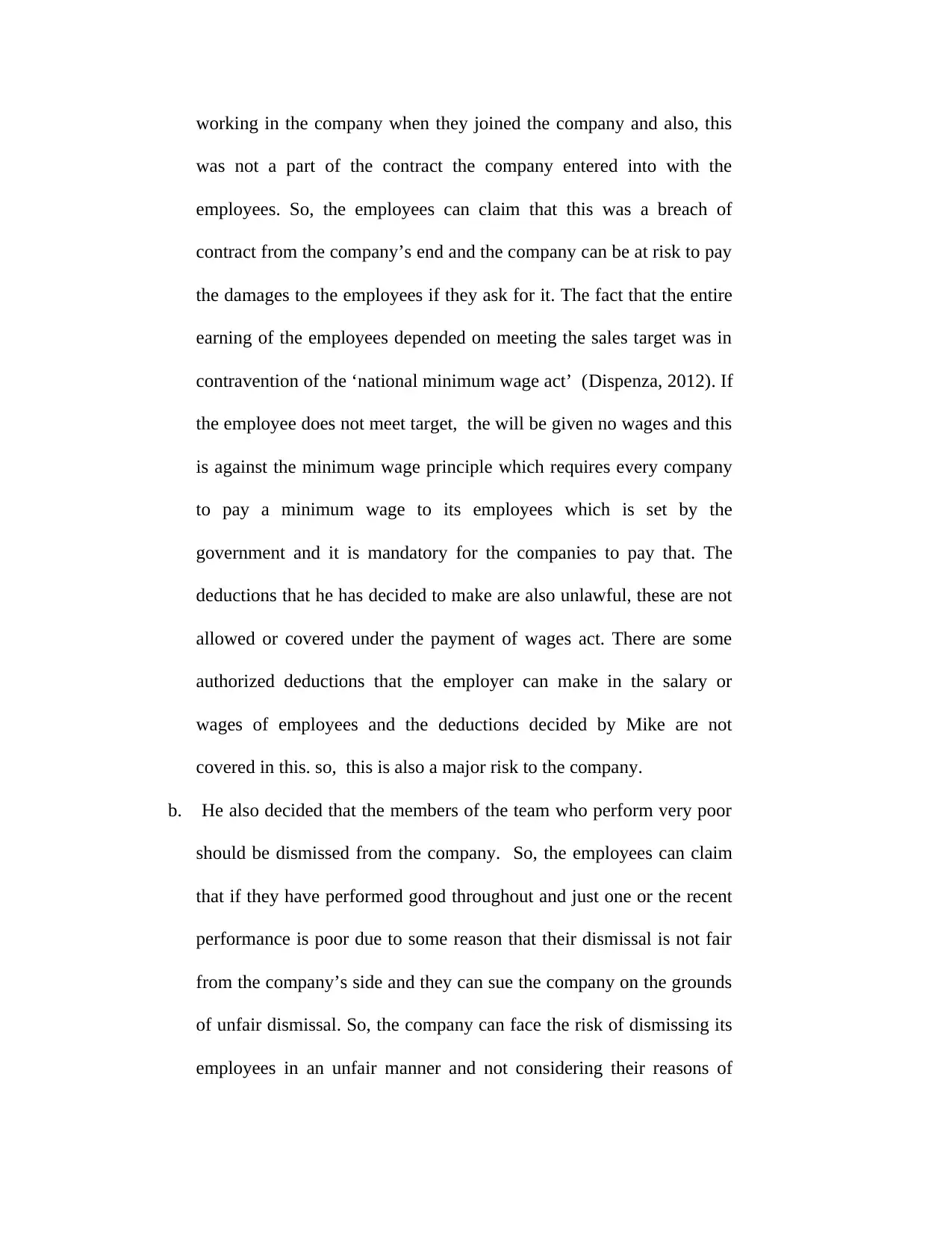
working in the company when they joined the company and also, this
was not a part of the contract the company entered into with the
employees. So, the employees can claim that this was a breach of
contract from the company’s end and the company can be at risk to pay
the damages to the employees if they ask for it. The fact that the entire
earning of the employees depended on meeting the sales target was in
contravention of the ‘national minimum wage act’ (Dispenza, 2012). If
the employee does not meet target, the will be given no wages and this
is against the minimum wage principle which requires every company
to pay a minimum wage to its employees which is set by the
government and it is mandatory for the companies to pay that. The
deductions that he has decided to make are also unlawful, these are not
allowed or covered under the payment of wages act. There are some
authorized deductions that the employer can make in the salary or
wages of employees and the deductions decided by Mike are not
covered in this. so, this is also a major risk to the company.
b. He also decided that the members of the team who perform very poor
should be dismissed from the company. So, the employees can claim
that if they have performed good throughout and just one or the recent
performance is poor due to some reason that their dismissal is not fair
from the company’s side and they can sue the company on the grounds
of unfair dismissal. So, the company can face the risk of dismissing its
employees in an unfair manner and not considering their reasons of
was not a part of the contract the company entered into with the
employees. So, the employees can claim that this was a breach of
contract from the company’s end and the company can be at risk to pay
the damages to the employees if they ask for it. The fact that the entire
earning of the employees depended on meeting the sales target was in
contravention of the ‘national minimum wage act’ (Dispenza, 2012). If
the employee does not meet target, the will be given no wages and this
is against the minimum wage principle which requires every company
to pay a minimum wage to its employees which is set by the
government and it is mandatory for the companies to pay that. The
deductions that he has decided to make are also unlawful, these are not
allowed or covered under the payment of wages act. There are some
authorized deductions that the employer can make in the salary or
wages of employees and the deductions decided by Mike are not
covered in this. so, this is also a major risk to the company.
b. He also decided that the members of the team who perform very poor
should be dismissed from the company. So, the employees can claim
that if they have performed good throughout and just one or the recent
performance is poor due to some reason that their dismissal is not fair
from the company’s side and they can sue the company on the grounds
of unfair dismissal. So, the company can face the risk of dismissing its
employees in an unfair manner and not considering their reasons of
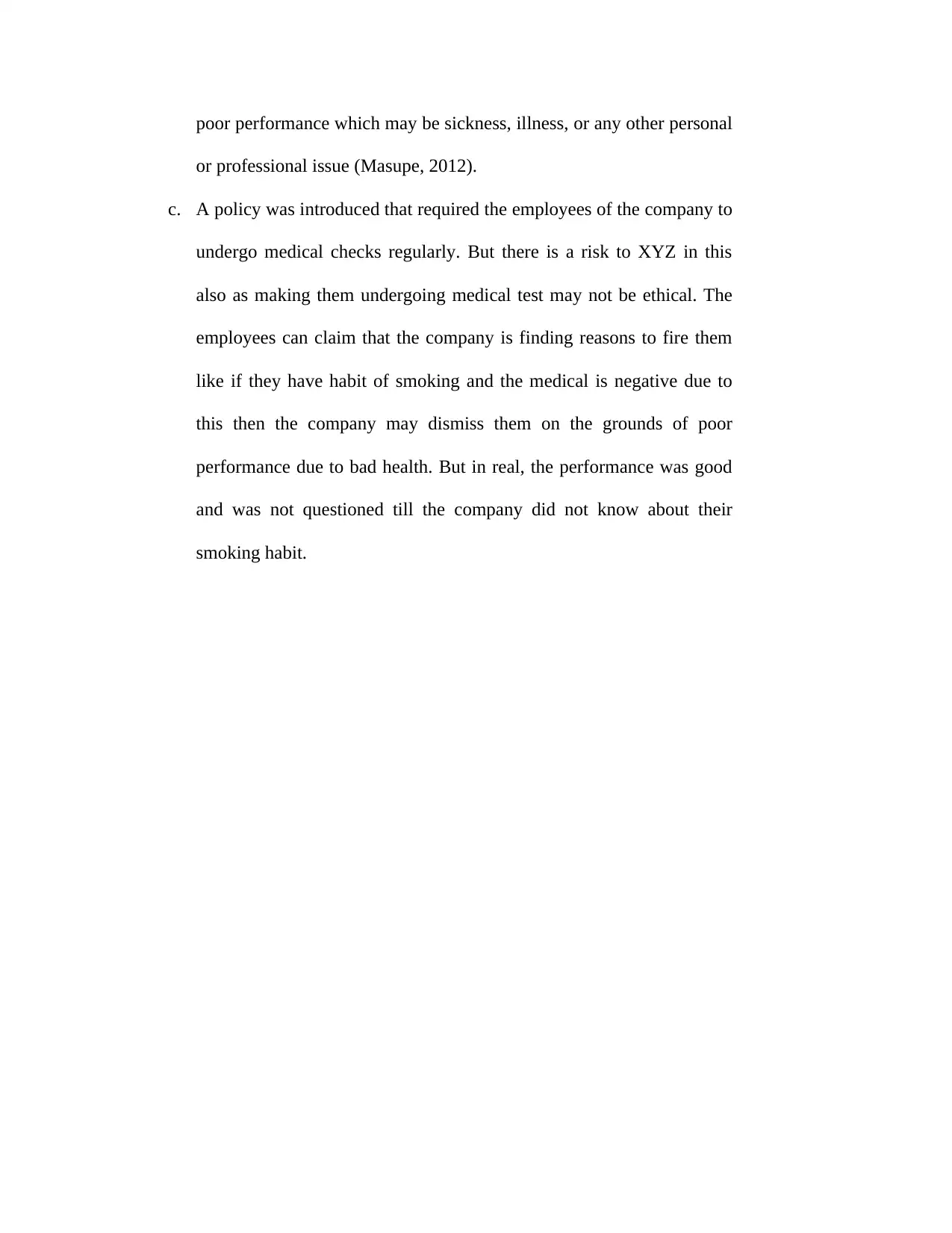
poor performance which may be sickness, illness, or any other personal
or professional issue (Masupe, 2012).
c. A policy was introduced that required the employees of the company to
undergo medical checks regularly. But there is a risk to XYZ in this
also as making them undergoing medical test may not be ethical. The
employees can claim that the company is finding reasons to fire them
like if they have habit of smoking and the medical is negative due to
this then the company may dismiss them on the grounds of poor
performance due to bad health. But in real, the performance was good
and was not questioned till the company did not know about their
smoking habit.
or professional issue (Masupe, 2012).
c. A policy was introduced that required the employees of the company to
undergo medical checks regularly. But there is a risk to XYZ in this
also as making them undergoing medical test may not be ethical. The
employees can claim that the company is finding reasons to fire them
like if they have habit of smoking and the medical is negative due to
this then the company may dismiss them on the grounds of poor
performance due to bad health. But in real, the performance was good
and was not questioned till the company did not know about their
smoking habit.
⊘ This is a preview!⊘
Do you want full access?
Subscribe today to unlock all pages.

Trusted by 1+ million students worldwide
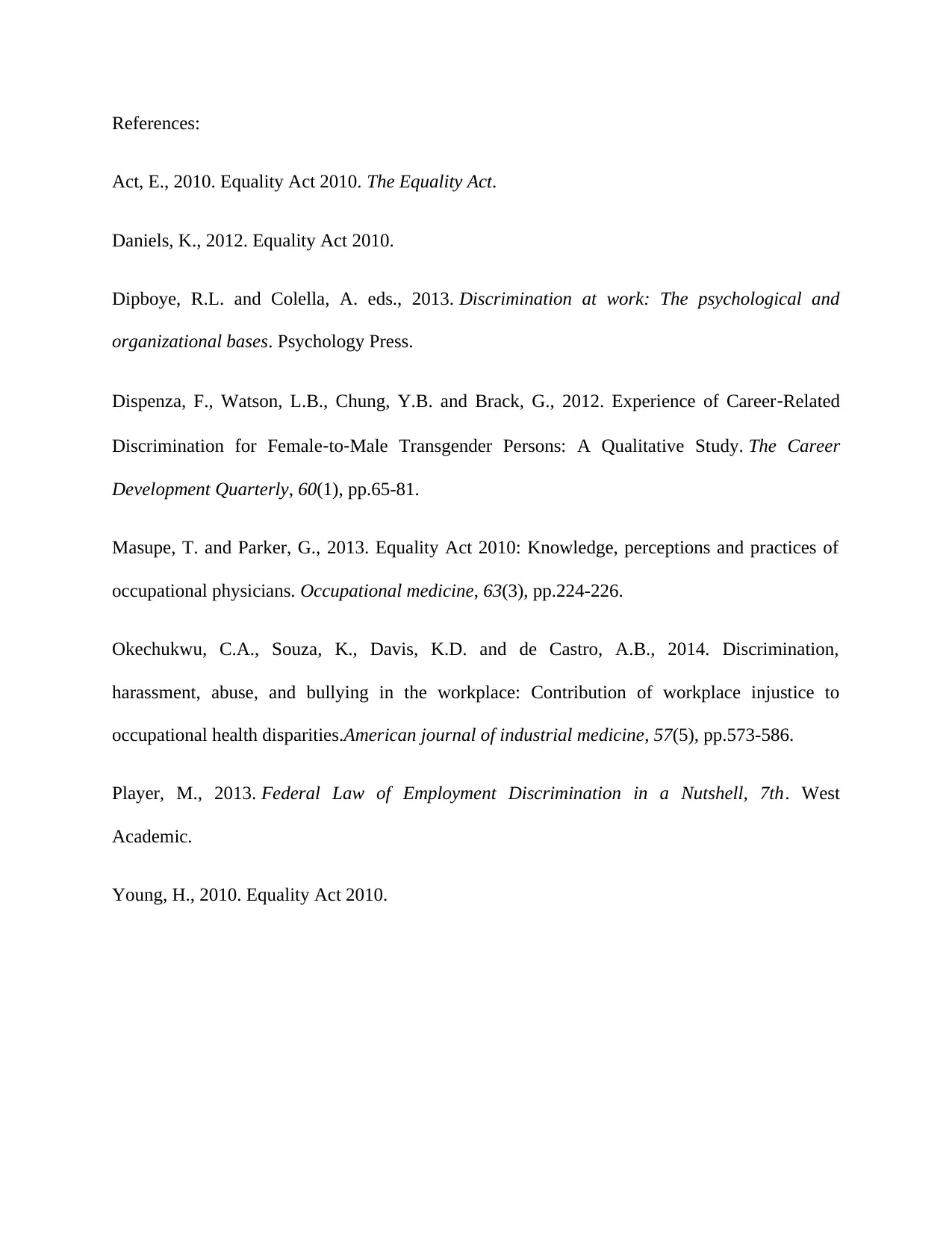
References:
Act, E., 2010. Equality Act 2010. The Equality Act.
Daniels, K., 2012. Equality Act 2010.
Dipboye, R.L. and Colella, A. eds., 2013. Discrimination at work: The psychological and
organizational bases. Psychology Press.
Dispenza, F., Watson, L.B., Chung, Y.B. and Brack, G., 2012. Experience of Career‐Related
Discrimination for Female‐to‐Male Transgender Persons: A Qualitative Study. The Career
Development Quarterly, 60(1), pp.65-81.
Masupe, T. and Parker, G., 2013. Equality Act 2010: Knowledge, perceptions and practices of
occupational physicians. Occupational medicine, 63(3), pp.224-226.
Okechukwu, C.A., Souza, K., Davis, K.D. and de Castro, A.B., 2014. Discrimination,
harassment, abuse, and bullying in the workplace: Contribution of workplace injustice to
occupational health disparities.American journal of industrial medicine, 57(5), pp.573-586.
Player, M., 2013. Federal Law of Employment Discrimination in a Nutshell, 7th. West
Academic.
Young, H., 2010. Equality Act 2010.
Act, E., 2010. Equality Act 2010. The Equality Act.
Daniels, K., 2012. Equality Act 2010.
Dipboye, R.L. and Colella, A. eds., 2013. Discrimination at work: The psychological and
organizational bases. Psychology Press.
Dispenza, F., Watson, L.B., Chung, Y.B. and Brack, G., 2012. Experience of Career‐Related
Discrimination for Female‐to‐Male Transgender Persons: A Qualitative Study. The Career
Development Quarterly, 60(1), pp.65-81.
Masupe, T. and Parker, G., 2013. Equality Act 2010: Knowledge, perceptions and practices of
occupational physicians. Occupational medicine, 63(3), pp.224-226.
Okechukwu, C.A., Souza, K., Davis, K.D. and de Castro, A.B., 2014. Discrimination,
harassment, abuse, and bullying in the workplace: Contribution of workplace injustice to
occupational health disparities.American journal of industrial medicine, 57(5), pp.573-586.
Player, M., 2013. Federal Law of Employment Discrimination in a Nutshell, 7th. West
Academic.
Young, H., 2010. Equality Act 2010.
1 out of 7
Related Documents
Your All-in-One AI-Powered Toolkit for Academic Success.
+13062052269
info@desklib.com
Available 24*7 on WhatsApp / Email
![[object Object]](/_next/static/media/star-bottom.7253800d.svg)
Unlock your academic potential
Copyright © 2020–2025 A2Z Services. All Rights Reserved. Developed and managed by ZUCOL.





